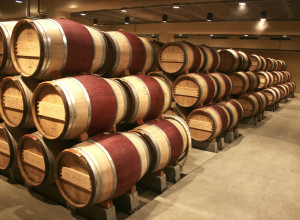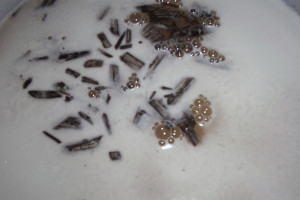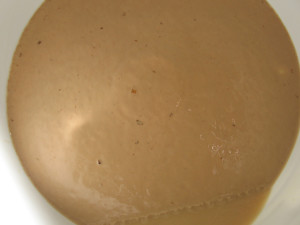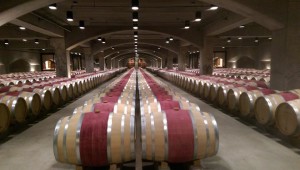The use of oak barrels in wine fermentation and aging is common, as it is known to increase wine aromatic complexity and improve overall wine quality. One downside to using oak barrel in winemaking is the fact that it costs more money to produce an oaked wine than it does to produce a wine made in stainless steel tanks. As a result of this cost differential, some wineries as well as home winemakers ultimately choose to
use alternatives to oak barrels that give similar aromatic and quality characteristics to the finished wine without the high costs.
One alternative approach is to use oak chips, staves, cubes, et cetera, in stainless steel tanks. In fact, I have a carboy of wine sitting in my cellar right now that’s soaking up the oaky glory from some oak shavings. Passing countless tiny oxygen bubbles through the wine (microoxygenation) allows for even more extraction of the oak flavor from the chips into the wine, reducing the amount of time needed in production and allowing the winery to get their product out faster to the consumer.
Another alternative, one of which we’ve described before on the blog, is to instead apply oak extracts directly to the grapevine. Theoretically, and as seen in studies, the resulting wines made from grapes sprayed with oak extract during the growing season retain the characteristics of these extracts, thus eliminating the need to age the wines in relatively expensive oak barrels or the need to use oak chips and the like.
These alternatives are not without their faults, however. For example in regards to oak chips, some winemakers have complained of too much variability between batches. Perhaps one batch was cut slightly larger than another batch, thus decreasing the oak-to-wine surface area and reducing the amount of oak flavor extracted. This lack of consistency could mean one tank of wine doesn’t extract enough oak flavors, while a different tank may extract too much.
To combat this over-extraction of oak flavor from using inconsistently cut oak chips, some researchers have suggested aging wine over the lees. Yeast, which makes up the vast majority of the lees, has been shown to mitigate overly excessive oak aromas from wines, and also has been shown to reduce other undesirable sensory characteristics, including those associated with ethyl-phenol and ochratoxin-A levels.
A new study published in the journal Food Chemistry has come up with a completely novel way to impart oak flavor in wines without actually using any oak barrels or oak chips. Building upon the knowledge that yeasts are relatively amenable to absorb varies compounds, and the fact that some wines use aging on the lees techniques to improve aromatic complexity, researchers have developed a way to inject oak flavor into yeast prior to fermentation and aging and have that yeast, or now “wood-aromatized yeast biomass”, act as the conduit through which the wine obtains its oak flavors and aromas.
Brief Methods
Quickly: The yeasts used in this study were the wine yeasts Saccharomyces cerevisiae (G37), the wine was made from Tempranillo grapes (Vitis vinifera) from Spain, and the wood sources used were acacia, chestnut, cherry, and American oak. Need more details, just ask!
To infuse the wood into the yeasts: Each of the wood sources went through an extraction process. After extraction, 10g of freeze-dried S. cerevisiae yeasts were added and left to soak up the extracts and dry over a period of time. After the joint drying process, the new “wood-aromatized yeast biomass” was washed prior to being added to the wine.
One gram of wood-aromatized yeasts was added to 500mL of wine, with each type of wood serving as a separate treatment. Untreated yeasts were used as controls. All treatments were performed in triplicate.
Wines were allowed to sit on the wood-aromatized yeast lees for a period of one month.
After one month, all wines and wood-aromatized yeasts were tested and analyzed for common wine phenolic and volatile compounds.
Sensory analysis of all wines was performed by a 10 judges with applicable experience. Judges were asked to rate the intensity of pre-determined sensory attributes, as well as an overall impression or acceptability score for each of the wines.
Results
Wood-Aromatized Yeasts
- 34 phenolic compound were identified in the wood-aromatized yeasts, including the following compounds found in both toasted and untoasted woods:
- Benzoic acid
- Cinnamic acid
- Many Aldehydes
- Many Flavonoids
- Phenolic compounds known only to specific wood types were only found in those yeasts that were infused with those woods (and thus could potentially be used for identification purposes later on if need be).
- 71 volatile compounds were identified in the wood-aromatized yeasts, most known to be found in traditional oak aged wines, including:
- Lactones
- Carbohydrate derivatives
- Volatile phenols
- Phenolic aldehydes
- Ketones
- Ethyl esters
- Lineal fatty acids
- Lactones & Carbohydrate derivatives:
- 5-hydroxymethylfurfural concentrations were significantly higher in cherry- and acacia- compared to oak-infused yeasts.
- Furfural, 5-methylfurfural, 5-hydroxymethylfurfural, and 2-furanmethanol concentrations were highest in cherry-infused yeasts (and were 3-5 times greater than the oak-infused yeasts).
- Whisky lactones were absent from acacia- and cherry-infused yeasts.
- Lignin:
- Chestnut-infused yeasts had the highest concentrations of lignin-related volatile phenolic compounds (smoky, spicy, etc).
- Phenolic Aldehydes:
- Vanillin, syringaldehyde, phenolic ketones, and vanillyl ethyl ether levels were highest in chestnut-infused yeasts.
- 2,4-dihydroxybenzaldehyde was found in acacia-infused yeasts.
- Linear Fatty Acids & Ethyl Esters:
- Cherry-infused yeasts had linear fatty acid and ethyl ester levels 3-4 times higher than all other wood-infused yeasts.
Wine Aged with Wood-Aromatized Yeasts
- The phenolic composition of Tempranillo wines was significantly different between treatments.
- Hydroxybenzoic and hydroxycinnamic aldehydes were not found in any of the wines.
- Robinetin and dihydrorobinetin were only found in wine samples aged on acacia-infused yeasts.
- Aromadendrin was only found in wine samples aged on cherry-infused yeasts.
- A greater ratio of gallic and ellagic acids was seen in wine samples aged on chestnut-infused yeasts compared with wine samples aged on oak-infused yeasts.
- The volatile phenolic compound composition of Tempranillo wines was significantly different between treatments.
- 3,4-dimethoxyphenol and 2,4-dihydroxybenzaldehyde were only found in wines aged on acacia-infused yeasts.
- p-anisaldehyde was only found in wines aged on cherry-infused yeasts.
- Phenolic aldehydes and phenylketones were found to be at higher levels in wines aged on chestnut-infused yeasts compared with the other treatments.
- 4-vinylguaicol and 4-vinylphenol (compounds associated with wood) were higher in wines aged on wood-infused yeasts compared with untreated controls.
Sensory Evaluation
- Color intensity was similar across all treatments.
- Untreated controls were judged to be the poorest quality wine.
- Wine aroma was judged to improve with wood-infused yeast aging treatment.
- Wines aged on chestnut-infused yeasts were reported to have the greatest concentrations of “woody aromas” compared with the other treatments.
- Note: this makes sense due to its higher concentration of phenolic aldehydes.
- Wines aged on chestnut-infused yeasts received higher scores for plum, currant, spicy, roasted, and nutty aromas.
- Vanilla and woody aromas were also noted in the other wood-infused treatments, though not to the extent of the chestnut-infused treatment.
- Best scores for flavor on the palate went to wines aged on chestnut- and cherry-infused yeasts.
- Astringency was highest for wines aged on chestnut-infused yeasts.
- Note: this makes sense due to its higher concentrations of gallic acid.
- Wines aged on cherry-, acacia– and oak-infused yeasts all tasted relatively similar, while wines aged on chestnut-infused yeasts tasted very different.
- Wines aged on a mixture of wood-infused yeasts provided the most complex and most balanced sensory characteristics.
Conclusions
The results of this study seem to suggest that infusing wood extracts into Saccharomyces cerevisiae yeasts may be an acceptable short-term alternative to oak barrel aging in Tempranillo wines. All of the wood-infused yeasts attained some wood-related compounds and sensory characteristics, indicating that the infusion was at least in part successful. Specifically, the chestnut-infused yeasts appeared to perform the best out of all of the wood-infused yeast treatments.
What is unknown, however, is how these wood-infused yeast treatments compare to traditional oak barrel treatments as well as newer oak chip or foliar oak extract treatments. From the sensory analysis in this
study, it is clear that the wines aged for a short period of time on the wood-infused yeasts were markedly better in terms of flavors, aromas, and overall quality, but how does this improvement compare with more traditional methods? Are the sensory and quality parameters equal? Or is one or more treatments far superior? Sure, aging on wood-infused yeasts is better than nothing, but is it better or at least comparable to what’s already on the market? Further research needs to be done in order to get at this question.
While this is just the first study of its kind and therefore much more work should be done before I can give sweeping recommendations (or not!), the novelty of the approach is certainly very interesting and it’s always fun to see science come up with different ways to obtain similar outcomes.
If you have any thoughts or questions related to this study, or if you know someone who is experimenting with something similar, please feel free to comment and share your experiences with us!
Source:





3 comments for “Wood-Infused Yeasts For Aging on the Lees: A Novel Approach to Achieve Oak Character in Wine”